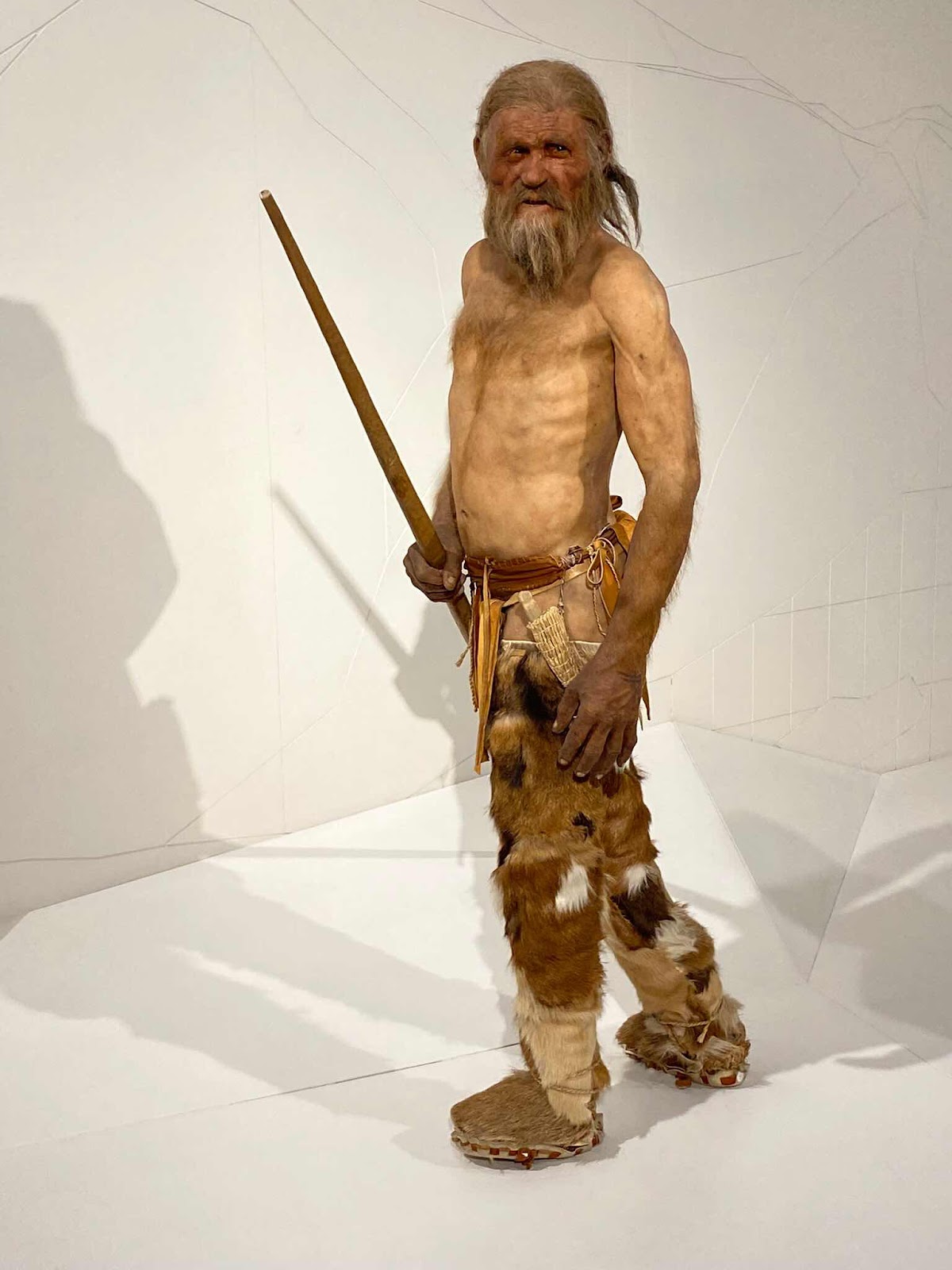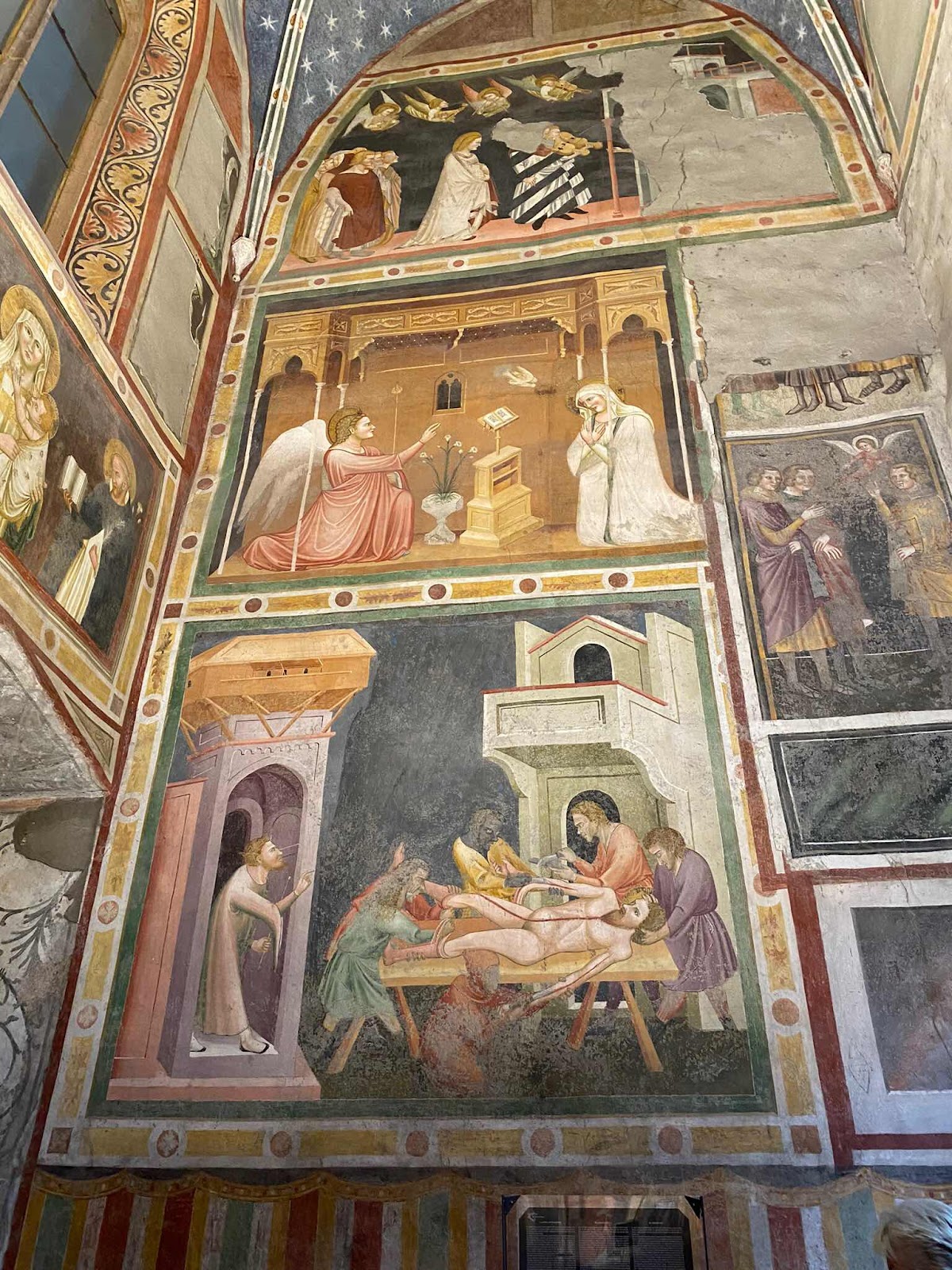We started the day with a visit to Bolzano, a town north of Molveno and considerably closer to the Austrian border. Like Trento which we visited yesterday, it was originally a Raetian settlement conquered by the Romans and its history seems to be very similar to that to Trento, though it, perhaps happily, lacked the presence of any prince bishops.
We had to be dropped well outside the historic centre where tourist buses are not allowed, and walk through an underpass and a building site to reach the main square which is called Piazza Walter. It was named after a well-know medieval German poet, Walther von der Vogelweide, of whom I had never heard, to my shame. Mind you, neither has Apple autocorrect, so it has taken quite a while to correct the nonsense it insisted in making out of his name. There is a large statue of him in the centre of the square.
Also in the square was the cathedral, with a roof similar to those we have seen in Vienna.
It was built in the 14th century and has friezes pained by a pupil of Giotto, so I really wanted to go in. However, the group was being led through the town to see other places, so we followed the group to be introduced other parts of the city, resolving to return later. This turned out to have been a serious mistake, unfortunately.
We walked through the town, admiring the many renaissance buildings, but I photographed nothing because we were all walking quite fast and I intended to return when we had more time. Sadly, we never had more time. We passed through the piazza that used to be the ancient grain market (Piazza del Grano) and then under a series of Renaissance arcades. We were very grateful for the shade as it was already becoming hot. We passed through Piazza Erbe which housed the daily market. This was another place I intended to photograph and never managed. Eventually we arrived at the Ötzi museum, which is the one everybody visits, to see Ötzi the iceman, a murder victim from 5300 years ago whose body was discovered appearing from a melting glacier in 1991.
Not only can you see his body, you can also see the amazing things that were found with him. His bear skin cap looks quite modern. He was wearing goat skin leggings and hay stuffed shoes, a skin loincloth, a skin coat and a grass matting cloak. He was carrying a huge bow and arrows, a copper axe and a dagger and all sorts of tools in a backpack. All of these things can be seen. Unfortunately, they can’t be photographed. I hadn’t noticed this prohibition and had photographed the mummy before I realised it. So here is the mummy, which is stored in a fridge and can only be viewed through a small window.
 I’m afraid it’s a terrible photo, but once I had realised it wasn’t supposed to be photographed at all I obviously could take a better one. So this is the best I could do, with all the reflections in the windows of people behind me.
I’m afraid it’s a terrible photo, but once I had realised it wasn’t supposed to be photographed at all I obviously could take a better one. So this is the best I could do, with all the reflections in the windows of people behind me.
The museum is quite extensive and on several floors, explaining the origin of all the things he had and where they might have come from. There a versions made by the scientists to show what his belongings looking like when made today. I found the backpack particularly interesting. It had a wooden frame that looked quite like todays serious backpacks, and was thought to carry a large netting bag.
There is also a life sized waxwork of what they think he looked like, using evidence from his mummy and from his DNA.
 He was about my height, and the longbow he was carrying is a good deal taller.
He was about my height, and the longbow he was carrying is a good deal taller.We spent quite a while in the museum, there’s a lot to read about and it’s all very accessible and easy to understand, as well as being in Italian, German and English.
We walked back the way we had come to the Piazza Erbe and the market, which I once again failed to photograph, and turned down the street towards the Dominican Church, because I wanted to see the frescos there.
The Church dedicated to St Dominic is what remains of a Dominican monastery, which is known to have existed since 1272. It is of gothic structure with some 14th century frescoes, and is mostly wonderfully austere. (That’s a baroque ceiling painting which I don’t like in the bit of the church that can be seen behind the organ.)
 There are the remains of the 14th century frescos in the church itself, but what I had come to see was the St John chapel, entirely frescoed in 1330 in the style of the Scrivegni chapel in Padua, and done by painters of the school of Giotto.
There are the remains of the 14th century frescos in the church itself, but what I had come to see was the St John chapel, entirely frescoed in 1330 in the style of the Scrivegni chapel in Padua, and done by painters of the school of Giotto.
It’s very hard to photograph, so though I took a lot of photos, I couldn’t get a good one of the whole place. The whole chapel is covered in scenes from the Bible or the lives of saints. The ceiling is covered in stars, and painted structural features enclosing medallions of busts of the prophets.
Many of the panels are damaged, especially the lower ones, but there is still much to see. I think I would need a detailed explanation of many of the panels, though some are obvious.
 The centre one above is obviously an annunciation. But I’m far from sure about the top and bottom ones.
The centre one above is obviously an annunciation. But I’m far from sure about the top and bottom ones.
I particularly liked the panel below, of the flight into Egypt. This is a master painter, with a sense of humour.
 If you are able to make this one big enough, you can see that Mary and Joseph are very obviously having a quarrel. He is shouting at her, and she had a face like thunder. The donkey just looks long-suffering - I get the impression he has heard it all before!
If you are able to make this one big enough, you can see that Mary and Joseph are very obviously having a quarrel. He is shouting at her, and she had a face like thunder. The donkey just looks long-suffering - I get the impression he has heard it all before!
As my back was starting to complain about the standing about, we stopped to rest it and have a quick coffee. Then we bought lunch sandwiches, giving ourselves 45 minutes to see the cathedral and make a start on our sandwiches before meeting our group under a big tree outside the cathedral. Unfortunately, the cathedral turned out to be closed for a wedding, so I never managed to see the second lot of frescos. We remained on a bench outside, hoping the wedding would soon be over and eating our sandwiches, but the wedding was still taking place as we left.
After we had met our group and found our way back to the bus, we were driven to the cable car station so we could take the cable car up to Soprabolzano. The cable car was one of the biggest ones I have been in, easily holding 16 of us as well as several other people, and the views on the way up were amazing.
 It was quite a long trip, as Soprabolzano is 1000m above Bolzano. Once at Soprabolzano, we were able to get out of the cable car and straight into the train for Collabo. This little train crosses the Renon plateau, stopping at several tiny stations on the way to Collabo. Just as on the bus, you have to press a button to let the driver know you want to get off at the next stop.
It was quite a long trip, as Soprabolzano is 1000m above Bolzano. Once at Soprabolzano, we were able to get out of the cable car and straight into the train for Collabo. This little train crosses the Renon plateau, stopping at several tiny stations on the way to Collabo. Just as on the bus, you have to press a button to let the driver know you want to get off at the next stop.
The plateau is largely covered with small farms, and we passed hay making and lots of cows and goats. At Collabo, we met our bus, which drove us to a place where we could walk a fairly short distance to see what are referred to locally as ‘earth pyramids’. They’re nothing like pyramids really, they’re spires of soft rock which are preserved because of the cap of hard rock on top of them.
 They have to be viewed from the opposite side of the valley because they aren’t very stable, but I hope my expanded photo shows at least some of the caps of hard rock. I had to use maximum zoom as the other side of the valley is quite far away. If the cap of hard rock falls off, the spires are soon eroded by wind and rain and disappear.
They have to be viewed from the opposite side of the valley because they aren’t very stable, but I hope my expanded photo shows at least some of the caps of hard rock. I had to use maximum zoom as the other side of the valley is quite far away. If the cap of hard rock falls off, the spires are soon eroded by wind and rain and disappear.
After this, the bus took us to a nice café where we had coffee (in my case) or beer (most of the men) and Apple strudel with cream and ice cream. Then it was quite a long journey back to Molveno and the hotel. It’s another 8.30 morning tomorrow, as we go to Lake Garda.